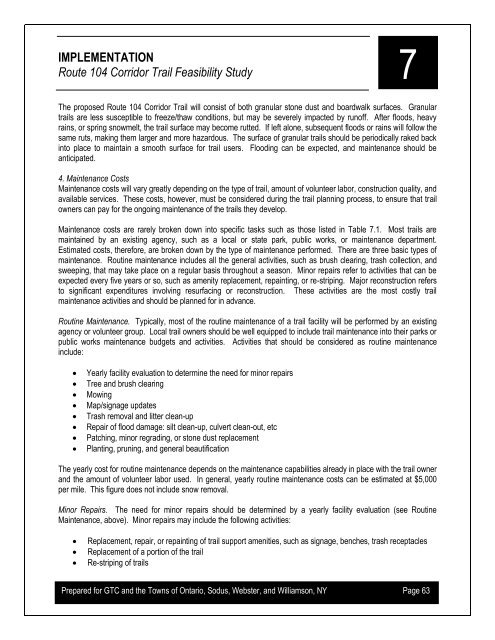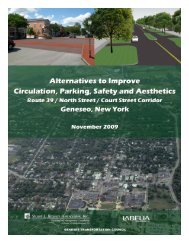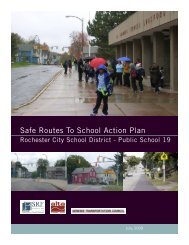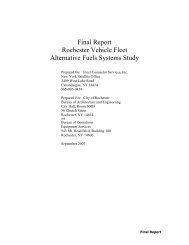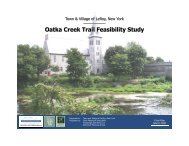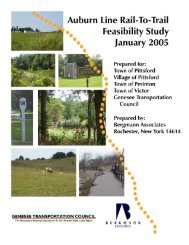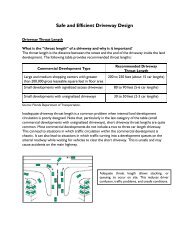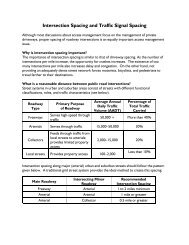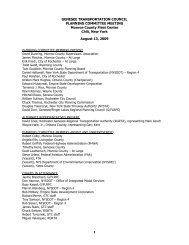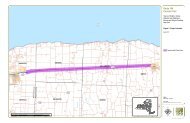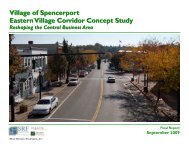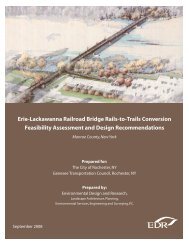Route 104 Corridor Trail Feasibility Study - Genesee Transportation ...
Route 104 Corridor Trail Feasibility Study - Genesee Transportation ...
Route 104 Corridor Trail Feasibility Study - Genesee Transportation ...
You also want an ePaper? Increase the reach of your titles
YUMPU automatically turns print PDFs into web optimized ePapers that Google loves.
IMPLEMENTATION<br />
7<br />
<strong>Route</strong> <strong>104</strong> <strong>Corridor</strong> <strong>Trail</strong> <strong>Feasibility</strong> <strong>Study</strong><br />
The proposed <strong>Route</strong> <strong>104</strong> <strong>Corridor</strong> <strong>Trail</strong> will consist of both granular stone dust and boardwalk surfaces. Granular<br />
trails are less susceptible to freeze/thaw conditions, but may be severely impacted by runoff. After floods, heavy<br />
rains, or spring snowmelt, the trail surface may become rutted. If left alone, subsequent floods or rains will follow the<br />
same ruts, making them larger and more hazardous. The surface of granular trails should be periodically raked back<br />
into place to maintain a smooth surface for trail users. Flooding can be expected, and maintenance should be<br />
anticipated.<br />
4. Maintenance Costs<br />
Maintenance costs will vary greatly depending on the type of trail, amount of volunteer labor, construction quality, and<br />
available services. These costs, however, must be considered during the trail planning process, to ensure that trail<br />
owners can pay for the ongoing maintenance of the trails they develop.<br />
Maintenance costs are rarely broken down into specific tasks such as those listed in Table 7.1. Most trails are<br />
maintained by an existing agency, such as a local or state park, public works, or maintenance department.<br />
Estimated costs, therefore, are broken down by the type of maintenance performed. There are three basic types of<br />
maintenance. Routine maintenance includes all the general activities, such as brush clearing, trash collection, and<br />
sweeping, that may take place on a regular basis throughout a season. Minor repairs refer to activities that can be<br />
expected every five years or so, such as amenity replacement, repainting, or re-striping. Major reconstruction refers<br />
to significant expenditures involving resurfacing or reconstruction. These activities are the most costly trail<br />
maintenance activities and should be planned for in advance.<br />
Routine Maintenance. Typically, most of the routine maintenance of a trail facility will be performed by an existing<br />
agency or volunteer group. Local trail owners should be well equipped to include trail maintenance into their parks or<br />
public works maintenance budgets and activities. Activities that should be considered as routine maintenance<br />
include:<br />
<br />
<br />
<br />
<br />
<br />
<br />
<br />
<br />
Yearly facility evaluation to determine the need for minor repairs<br />
Tree and brush clearing<br />
Mowing<br />
Map/signage updates<br />
Trash removal and litter clean-up<br />
Repair of flood damage: silt clean-up, culvert clean-out, etc<br />
Patching, minor regrading, or stone dust replacement<br />
Planting, pruning, and general beautification<br />
The yearly cost for routine maintenance depends on the maintenance capabilities already in place with the trail owner<br />
and the amount of volunteer labor used. In general, yearly routine maintenance costs can be estimated at $5,000<br />
per mile. This figure does not include snow removal.<br />
Minor Repairs. The need for minor repairs should be determined by a yearly facility evaluation (see Routine<br />
Maintenance, above). Minor repairs may include the following activities:<br />
<br />
<br />
<br />
Replacement, repair, or repainting of trail support amenities, such as signage, benches, trash receptacles<br />
Replacement of a portion of the trail<br />
Re-striping of trails<br />
Prepared for GTC and the Towns of Ontario, Sodus, Webster, and Williamson, NY Page 63


